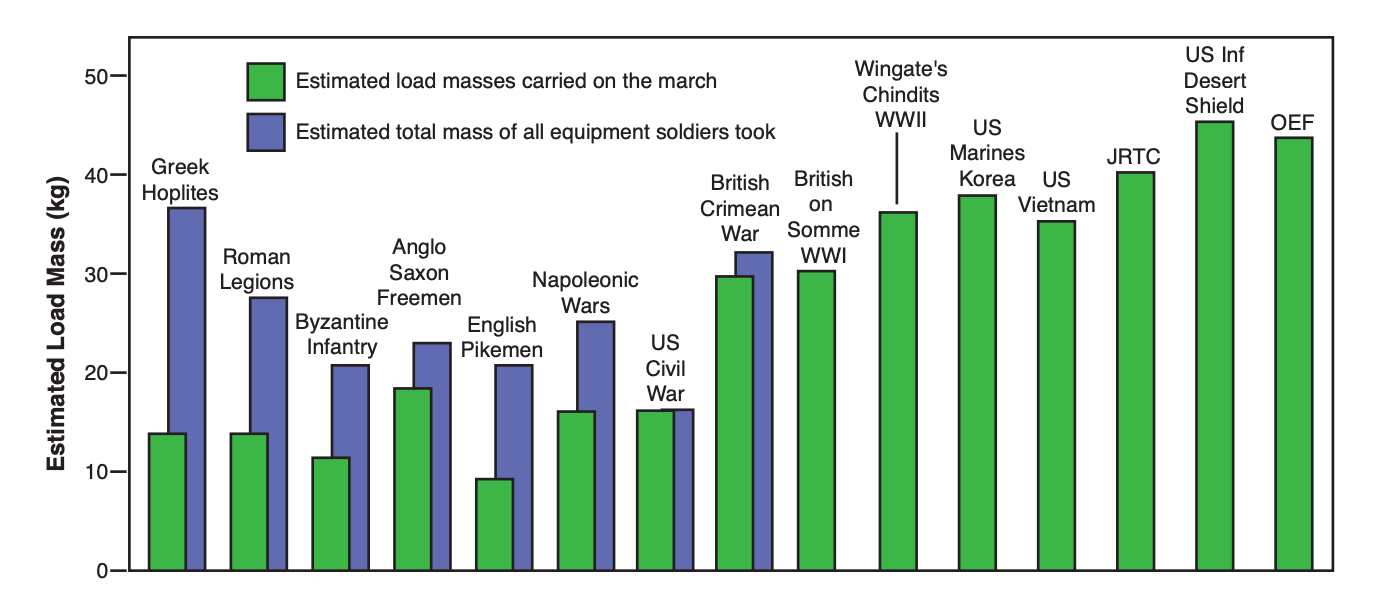The problem.
The Hidden Cost of Back Pain in the Military
Musculoskeletal injuries from heavy load carriage are one of the most common — and costly — problems faced by service members worldwide.
Every soldier carries the burden: body armor, ammo, water, comms, mission gear. Over long distances and extreme conditions, that weight grinds down the spine, causing lower back pain (LBP), chronic injury, and reduced readiness.
MORE GEAR.
MORE WEIGHT.
MORE RISK.

The Burden of Load Carriage
Lower back pain is the #1 musculoskeletal complaint in the military.
1.38 million limited-duty days lost for lower back and spine injuries (U.S. Army, 2017).
Estimated annual costs:
Over $100 billion in the U.S.
£2.8 billion in the UK
$4.8 billion in Australia
And that’s just medical bills and lost workdays. The ripple effects are worse: early medical discharges, reduced readiness, and the mental toll of chronic pain.
“LOAD CARRIAGE IN MILITARY OPERATIONS: A REVIEW OF HISTORICAL, PHYSIOLOGICAL, BIOMECHANICAL, AND MEDICAL ASPECTS”; JOSEPH KNAPIK, ScD; and KATY REYNOLDS, MD;2010
Why Loads Break Soldiers
Research is clear: ruck marches and load carriage cause 15–23% of all new injuries — second only to running and PT.
The damage adds up fast:
Lower back strain
Stress fractures
Knee pain
Rucksack palsy (nerve compression in the shoulders)
Foot injuries and blisters
Heavy loads force unnatural trunk lean, compress the spine, and create repetitive stress on muscles and ligaments.
THE FLEX SOLUTION
“Proper load carriage is essential to combat effectiveness.”
-ATP 3-21.18, US ARMY Doctrine
The Benefits of Flex
Injury Prevention → Reduce the cause of chronic back and shoulder pain.
Operational Efficiency → Soldiers move naturally, fatigue less, and access gear instantly.
Long-Term Savings → Fewer injuries = fewer discharges, lower medical bills, higher retention.
Seamless Integration → Works with existing armor and kit, no retraining required.
Redistribute the Weight. Protect the Soldier.
The Noctu Flex system was designed from the ground up to solve this exact problem. By shifting load from the shoulders to the hips, Flex reduces spinal compression, eases muscle strain, and keeps soldiers mission-ready longer.
Proven Biomechanical Benefits:
Hip belts drop shoulder pressure from 203 mmHg to 15 mmHg.
Increased pelvic rotation = better balance and walking efficiency.
Lower shoulder pressure = fewer long-term injuries.
Reduced energy cost of movement = improved endurance in the fight.
JUSTIFICATION.
A Strategic Imperative
Modern warfare is heavier than ever: advanced comms, protective plates, mission tools. Loads keep rising. Without innovation, injuries will rise with them.
The Evidence is Clear
Traditional load-bearing systems are failing soldiers. The Noctu Flex system changes the equation:
Redistributes weight to the hips
Prevents injury
Improves endurance
This isn’t just about comfort. It’s about readiness, survivability, and protecting the men and women who serve.
Flex isn’t a luxury — it’s a necessity




